高中英语阅读课教案:
高中英语阅读课教案
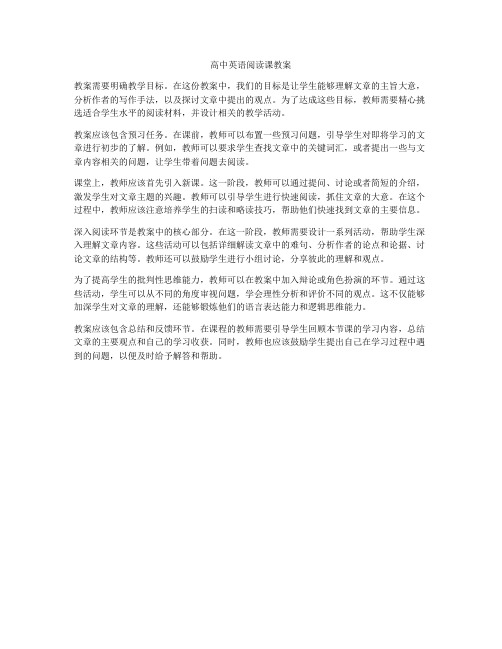
高中英语阅读课教案
教案需要明确教学目标。
在这份教案中,我们的目标是让学生能够理解文章的主旨大意,分析作者的写作手法,以及探讨文章中提出的观点。
为了达成这些目标,教师需要精心挑选适合学生水平的阅读材料,并设计相关的教学活动。
教案应该包含预习任务。
在课前,教师可以布置一些预习问题,引导学生对即将学习的文章进行初步的了解。
例如,教师可以要求学生查找文章中的关键词汇,或者提出一些与文章内容相关的问题,让学生带着问题去阅读。
课堂上,教师应该首先引入新课。
这一阶段,教师可以通过提问、讨论或者简短的介绍,激发学生对文章主题的兴趣。
教师可以引导学生进行快速阅读,抓住文章的大意。
在这个过程中,教师应该注意培养学生的扫读和略读技巧,帮助他们快速找到文章的主要信息。
深入阅读环节是教案中的核心部分。
在这一阶段,教师需要设计一系列活动,帮助学生深入理解文章内容。
这些活动可以包括详细解读文章中的难句、分析作者的论点和论据、讨论文章的结构等。
教师还可以鼓励学生进行小组讨论,分享彼此的理解和观点。
为了提高学生的批判性思维能力,教师可以在教案中加入辩论或角色扮演的环节。
通过这些活动,学生可以从不同的角度审视问题,学会理性分析和评价不同的观点。
这不仅能够加深学生对文章的理解,还能够锻炼他们的语言表达能力和逻辑思维能力。
教案应该包含总结和反馈环节。
在课程的教师需要引导学生回顾本节课的学习内容,总结文章的主要观点和自己的学习收获。
同时,教师也应该鼓励学生提出自己在学习过程中遇到的问题,以便及时给予解答和帮助。
教资高中英语阅读教学设计

增加词汇量:通过大量阅读,帮助学生扩大词汇量,提高词汇运用能力。
拓展文化视野:引导学生接触不同题材和风格的英语阅读材料,了解英语国家的文化背景,拓展 国际视野。
激发学生对英语阅读的兴趣和热 情
提高学生的阅读理解能力和阅读 速度
设计合理的评价标准,包括阅读理解能力、阅读速度、词汇量等方面。 定期进行阅读成果评价,及时发现学生的不足之处,并给予指导和帮助。 鼓励学生积极参与评价过程,让他们对自己的阅读成果有更清晰的认识。 根据评价结果,调整教学方法和策略,提高阅读教学的效果。
教学目标是否明确 教学内容是否符合学生实际水平 教学方法是否能够激发学生的学习兴趣和主动性 教学评价是否能够客观、全面地反映学生的学习情况
依据教学目标和学生需求选择阅读材料 考虑学生的语言水平和兴趣爱好 选取具有思想性、教育性和文化内涵的阅读材料 注重阅读材料的多样性和丰富性
基础阅读:教授学生基本的阅读技巧和词汇,提高阅读速度和理解能力 深入阅读:引导学生深入理解文本,培养批判性思维和阅读分析能力 拓展阅读:提供丰富多样的阅读材料,鼓励学生自主选择和拓展阅读范围 跨学科阅读:结合其他学科知识,引导学生将不同领域的知识融会贯通
选取贴近学生生活实际的阅读材料,激发阅读兴趣 设计具有实际意义的阅读任务,让学生在阅读中运用所学知识解决实际问题 鼓励学生通过阅读获取信息,提高信息处理和表达能力 结合阅读材料,开展英语口语、写作等实际应用活动,促进英语综合能力的提高
跨文化意识的定 义和重要性
高中英语阅读教 学中跨文化意识 的培养目标
案例:在高中英 语阅读教学中, 教师可以先让学 生讨论与课文主 题相关的话题, 激活学生的前知, 然后引导学生从 多个角度思考问 题,提高阅读理 解能力。
高中英语小说类文章阅读理解教案
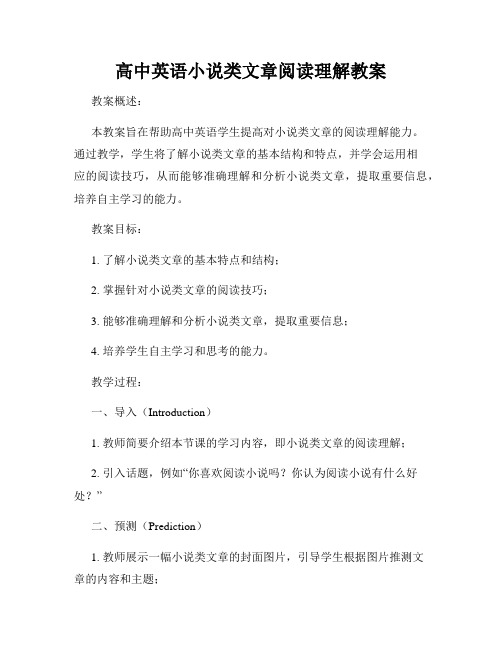
高中英语小说类文章阅读理解教案教案概述:本教案旨在帮助高中英语学生提高对小说类文章的阅读理解能力。
通过教学,学生将了解小说类文章的基本结构和特点,并学会运用相应的阅读技巧,从而能够准确理解和分析小说类文章,提取重要信息,培养自主学习的能力。
教案目标:1. 了解小说类文章的基本特点和结构;2. 掌握针对小说类文章的阅读技巧;3. 能够准确理解和分析小说类文章,提取重要信息;4. 培养学生自主学习和思考的能力。
教学过程:一、导入(Introduction)1. 教师简要介绍本节课的学习内容,即小说类文章的阅读理解;2. 引入话题,例如“你喜欢阅读小说吗?你认为阅读小说有什么好处?”二、预测(Prediction)1. 教师展示一幅小说类文章的封面图片,引导学生根据图片推测文章的内容和主题;2. 学生以小组为单位进行讨论,提出各自的预测,并与其他小组分享。
三、阅读指导(Reading Guidance)1. 教师引导学生了解小说类文章的基本结构,包括开头、主体和结尾;2. 学生分析已学过的小说类文章,掌握其常用的叙事方式和描写手法;3. 教师指导学生在阅读时注意关键词和重要细节,帮助理解整个故事情节。
四、阅读理解(Reading Comprehension)1. 学生独立阅读一篇小说类文章;2. 学生回答与文章内容相关的问题,包括主旨、人物、情节等方面;3. 学生将回答的问题进行整理,形成文章摘要或概括。
五、讨论与交流(Discussion and Communication)1. 学生以小组为单位进行讨论,互相交流自己对文章的理解和摘要;2. 每个小组派出一名代表进行汇报,分享各组的讨论成果。
六、总结与拓展(Summary and Extension)1. 教师对本节课的学习内容进行总结,强调小说类文章的阅读技巧;2. 教师提供更多小说类文章的阅读材料,供学生课后拓展阅读。
教学反思:通过本节课的教学,学生不仅了解了小说类文章的基本结构和特点,还学会了阅读技巧,增强了对小说类文章的阅读理解能力。
高中英语人教必修一第四单元阅读课教学设计
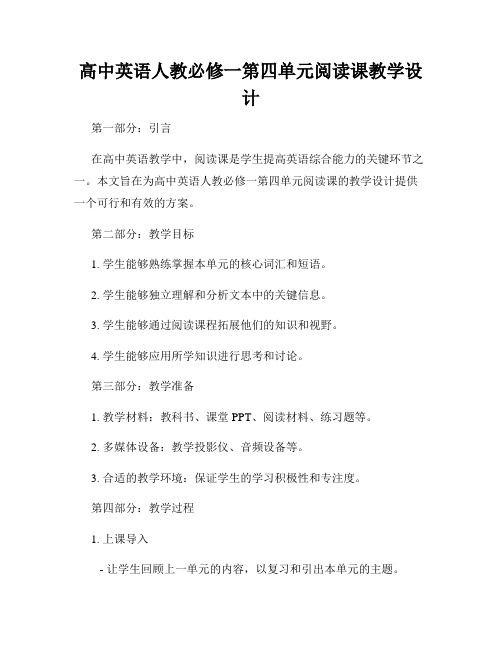
高中英语人教必修一第四单元阅读课教学设计第一部分:引言在高中英语教学中,阅读课是学生提高英语综合能力的关键环节之一。
本文旨在为高中英语人教必修一第四单元阅读课的教学设计提供一个可行和有效的方案。
第二部分:教学目标1. 学生能够熟练掌握本单元的核心词汇和短语。
2. 学生能够独立理解和分析文本中的关键信息。
3. 学生能够通过阅读课程拓展他们的知识和视野。
4. 学生能够应用所学知识进行思考和讨论。
第三部分:教学准备1. 教学材料:教科书、课堂PPT、阅读材料、练习题等。
2. 多媒体设备:教学投影仪、音频设备等。
3. 合适的教学环境:保证学生的学习积极性和专注度。
第四部分:教学过程1. 上课导入- 让学生回顾上一单元的内容,以复习和引出本单元的主题。
- 引入本单元的主题,激发学生的学习兴趣。
2. 预习任务- 学生在课前阅读教科书中的相关阅读材料,了解文章的大意和关键内容。
- 学生可以在教室中小组讨论或写下一到两个问题。
3. 教师示范- 教师用板书或PPT展示关键词汇和短语,并解释其意义和用法。
- 教师带领学生朗读和理解文本中的关键句子和段落。
4. 学生合作活动- 学生以小组形式讨论和分享他们的预习问题,教师引导他们扩展思维和观点。
- 学生可以进行角色扮演或小组演示,以提高他们的口语表达能力。
5. 阅读理解- 学生阅读教科书中的阅读材料,并回答与之相关的问题。
- 教师可进行个别辅导,帮助学生理解和解决阅读中的困惑。
6. 扩展活动- 教师可安排一些扩展活动,如观看相关视频、听取相关音频或阅读相关文章。
- 学生可以进行小组讨论或写下他们的观点和反思。
7. 总结评价- 教师对学生的表现进行评价和总结,鼓励他们的努力和进步。
- 学生可以自评和互评,以促进他们的学习动力和自我反思。
第五部分:作业布置1. 学生可完成课后阅读和练习题,巩固对本单元内容的理解和掌握。
2. 学生可撰写一篇关于本单元主题的小作文,以提高他们的写作能力。
高中英语阅读教案全英

高中英语阅读教案全英【篇一:高中英语阅读教案】高中英语阅读课教案book5 unit 5 first aid for burns授课董红英一、teaching aims:1. knowledge aims:(1) get the students to learn some useful words and expressions in the passage;focus:2. ability aims:(1) enable the students to learn how to use what they’ve learnt to do first aid treatment for burns correctly;(2) let the students learn the reading skills of getting the main idea of each para part;(3) train the students’ reading abilities, such as skimming and scanning;(4) to develop the students’ ability to get the text information through reading practice;(5) to develop the students’ speaking skills;(6) to challenge the students to express a real-life even and share experiences with others in the topic.3. morality aims:(1) enable the students to be brave, calm when facing such accidents and know how to give first aid in different situations;(2)develop students’ sense of cooperative learning and their abilities of discovery;(3)to motivate the students to concern about others and their safeties二、key points and difficult pointskey points: (1). get the students to imitate the pronunciation and the intonation.(2). to arouse their interest in the lesson.(3). improve the ss’ reading a bilities and develop their reading skills.(4). to develop students’ speaking skills in describing a specific situation where they make storieswith the first aid treatment they have learnt in this lesson. difficult points: (1).to improve the ss’ reading abilities and develop their reading skills; .(2). to help the ss use what they’ve learnt to do first aid treatment for burns correctly. (3). to develop students’ speaking skill in describing a specific situation where they makestories with first aid treatment in this lesson.三、teaching procedures:step 1:watching and thinking1. i will begin the lesson by playing a video and help the students to find out “what happened to the boy? what did the man do before a doctor can be f ound?”, which is to lead in the topic: “first aid”, and get the students ready for the further discussion “what is first aid?”. help the students to get the answer “first aid is a temporary form of help given to someone who suddenly falls ill or gets injured before a doctor can be found”, and explain the new word “temporary---lasting or serving for a time only, not permanent”.(2) while helping the students finish all the exercises, i will carry out a competition: divide the students into four groups, and the one who stand up fast and give the right answer can get 1 mark for his\her group, the group which gets the highest mark will get a present.step 2:fast reading1. give the students a minute and some tips to help them divide the passage into 5 parts and find out the main idea of each part.questions:1. how many parts can the passage be divided into?2. what is the main idea of each part?part 1 a. the characteristics of three kinds of burnspart 2 b. the three types of burnspart 3 c. different first aid treatment for different burnspart 4 d. the functions of the skinpart 5 e. how we get burnedstep 3:careful reading1. get the students finish some comprehensive exercises, and help them to get the key information of each part. try to make the students finish these exercises creatively and actively;1). listen to the tape of part1 and find out: the functions of skin1. protect you against poisons and the sun’s harmful rays;2. keep you .4. give you .2). listen to the tape of part2 and find out the causes of burns3). listen to the tape of part3 and find out: types of burnsthere are three types of burns depending on which layers are burned.first degree burns affect only the _____ layer and should feel better within _______________.second degree burns affect both the top and the_______ layer. these burns are serious and take ______________ to heal.third degree burns affect all three layers and any ______ and organs under the skin. they are very severe injuries and the victim must get to hospital at once.4). listen to the tape of part 4 and find out the characteristics of burns5). listen to the tape of part 5 and find out the treatment for first aid1. ________ clothing and jewelry near the burns.2. ______ the burns with cool but not icy water.3. ______ cool, clean wet cloths on the burns.4. ______ the burned area gently.5. ______ the burned area with a dry clean bandage.6. ______ the burned area higher than the heart, if possible.7. ______ the victim to the doctor or hospital, if the injuries are second or third degreeburns.2. get the students to read the passage aloud while they are listening to the tape, ask the students to pay attention to the pronunciation and the intonation;3. guide the students if necessary, and always encourage them, encouragement can build their confidences.step 4:post reading:1. to practise the use of group and pair activities, with the emphasis on communicating with their partners and the cooperation of teams.2. guide the students to find out the correct answer and remind them of paying attention to the key words.(1). the passage is mainly about __________.a. the function of the three layers of the skinb. the characteristics of burnsc. burns and the first aidd. steps of treatment for different burns(2). you can get burns by various things, except __________.a. the sun or hot liquidsb. steam or radiationc. fire or the lightd. electricity or chemicals(3). when you get the second degree burns, you can carry out the following first aid except _______.a. cool the burns immediately with the icy waterb. get a doctor to help you at oncec. place cool cloths on the burned area repeatedlyd. dry the burned area gently3. help the students summarize some useful reading skills.4. to process information and to apply knowledge to solve a problem.step5: conclusion of reading skills1.help the students discover some reading skills through reading a similar passage.2. develop the students’ learning-by-doing abilities【篇二:高中英语阅读教案】英语阅读教案objectives1.to find out some specific facts of the passage2.to study some useful expressions and new words in the text.3.to make up a conversation between marco polo and the author4.to practise writing a reportteaching procedures:step 1 lead-in ( 歌曲导入 )t: good morning , class.ss: good morning , madam .t: today let’s begin our class with the beautiful song “a whole new world”. we have been learning the song these days. now listen , enjoy and learn to sing the song again.step 2 group discussion ( 小组讨论 )t: what is the song about ? what do you think of the song? sa: it’s about a whole new world. ??.sb: it’s beautiful. ??.t: good. now look at the screen. china in the yuan dynasty was a whole new world to marco polo. today let’s read a passage marco polo. have you ever heard of marco polo? do you know kublai ? what do you know about the yuan dynasty?( show the pictures of marco polo and some people in italy, kublai and some people in the yuan dynasty.)t: let’s have group discussion. each group has its own question. group one : who was marco polo? what do you know about marco polo? group two :who was kublai ? what do you know about kublai? group three:what do you know about the yuan dynasty?group four: what do you know about italy?step 3 vocabulary studyt: here are some important words which are frequently used when we talk about marco polo.look them up in the dictionary . write down the sentences and english explanations.faithful / fantastic / imprison / awed / missionstep 4 fast-reading ( 快速阅读)t: now, let’s read the passage marco polo and his travels . read the text as quickly as possible.try to find the answers to the questions on the screen.1.why did marco and his father travel to china?2.why was the emperor impressed with marco?3.why was marco surprised to see people using paper money?4.what were the black stones marco saw people burning for fuel?5.how long did marco spend in china?step 5 听录音、观图像。
英语阅读理解公开课教案高中
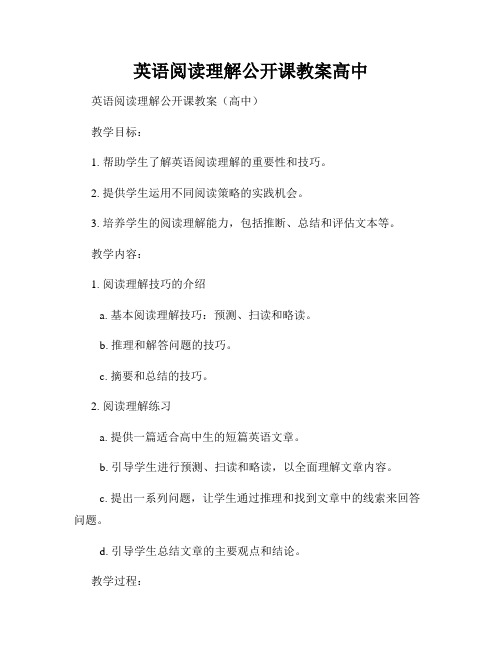
英语阅读理解公开课教案高中英语阅读理解公开课教案(高中)教学目标:1. 帮助学生了解英语阅读理解的重要性和技巧。
2. 提供学生运用不同阅读策略的实践机会。
3. 培养学生的阅读理解能力,包括推断、总结和评估文本等。
教学内容:1. 阅读理解技巧的介绍a. 基本阅读理解技巧:预测、扫读和略读。
b. 推理和解答问题的技巧。
c. 摘要和总结的技巧。
2. 阅读理解练习a. 提供一篇适合高中生的短篇英语文章。
b. 引导学生进行预测、扫读和略读,以全面理解文章内容。
c. 提出一系列问题,让学生通过推理和找到文章中的线索来回答问题。
d. 引导学生总结文章的主要观点和结论。
教学过程:1. 创设情境,引入话题在开始本节课之前,教师可以向学生简要介绍英语阅读理解的重要性,并提问学生他们在日常生活中有何困难。
2. 介绍阅读理解技巧a. 预测:让学生通过阅读标题、副标题和首段,猜测文章主题和内容。
b. 扫读:要求学生快速阅读全文,获取整体理解,并注意段落标题以及文字格式变化的线索。
c. 略读:鼓励学生在继续阅读之前,先浏览全文段落,从而了解文章的结构和组织方式。
3. 演示阅读理解技巧配合一篇短篇英语文章,教师可以演示如何使用上述技巧来理解文章,并解答一些与文章相关的问题。
4. 学生练习阅读理解技巧学生独立阅读一篇短篇英语文章,然后根据老师提出的问题,应用上述技巧进行阅读理解,并完成问题解答。
5. 学生总结文章的主要观点和结论学生可以用自己的语言总结文章的主要观点和结论,并与同学分享。
6. 教师评价和反馈教师对学生的阅读理解技巧运用和问题解答进行评价,并给予适当的反馈。
教学资源:1. 适合高中生的短篇英语文章。
2. 学生练习用的问题列表。
3. 提供学生总结的示范。
教学评估:1. 教师观察学生在阅读理解过程中使用的技巧和策略。
2. 对学生的问题解答和总结进行评估,查看他们对文章的理解程度。
3. 学生之间的互评,让他们根据彼此的回答和总结,提供反馈和建议。
高中英语阅读教学教案设计
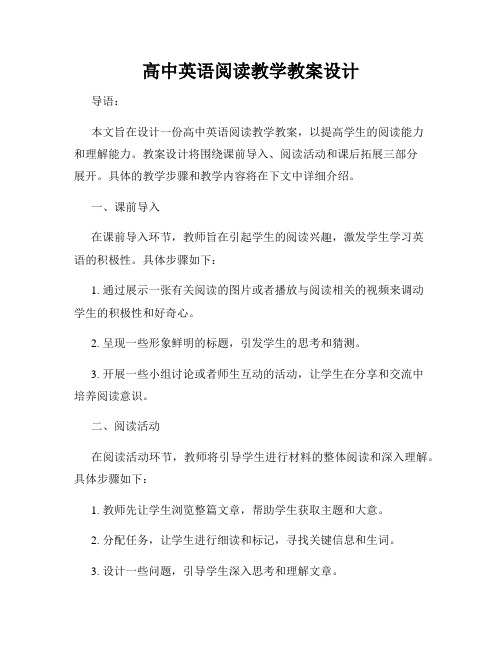
高中英语阅读教学教案设计导语:本文旨在设计一份高中英语阅读教学教案,以提高学生的阅读能力和理解能力。
教案设计将围绕课前导入、阅读活动和课后拓展三部分展开。
具体的教学步骤和教学内容将在下文中详细介绍。
一、课前导入在课前导入环节,教师旨在引起学生的阅读兴趣,激发学生学习英语的积极性。
具体步骤如下:1. 通过展示一张有关阅读的图片或者播放与阅读相关的视频来调动学生的积极性和好奇心。
2. 呈现一些形象鲜明的标题,引发学生的思考和猜测。
3. 开展一些小组讨论或者师生互动的活动,让学生在分享和交流中培养阅读意识。
二、阅读活动在阅读活动环节,教师将引导学生进行材料的整体阅读和深入理解。
具体步骤如下:1. 教师先让学生浏览整篇文章,帮助学生获取主题和大意。
2. 分配任务,让学生进行细读和标记,寻找关键信息和生词。
3. 设计一些问题,引导学生深入思考和理解文章。
4. 帮助学生掌握阅读策略,如扫读、略读和精读。
5. 引导学生进行词汇和语法的分析,培养学生的语言运用能力。
三、课后拓展在课后拓展环节,教师将组织学生进行一些拓展活动,以促进学生在阅读中的自主学习和思考。
具体步骤如下:1. 布置一些与文章内容相关的作业,如写一篇小短文、设计一个续写、形成自己的问题等,以检验学生对文章的理解和运用能力。
2. 推荐一些相关的阅读材料,鼓励学生拓宽阅读视野。
3. 鼓励学生与同学分享自己的阅读心得和体会,培养合作学习的氛围。
结语:通过本节课的阅读教学活动,学生应该能够提高他们的阅读能力和理解能力,同时也能培养他们的自主学习和合作学习的能力。
希望通过本教案设计,能够为高中英语阅读教学提供一种有效的教学参考。
高中英语补充阅读教案
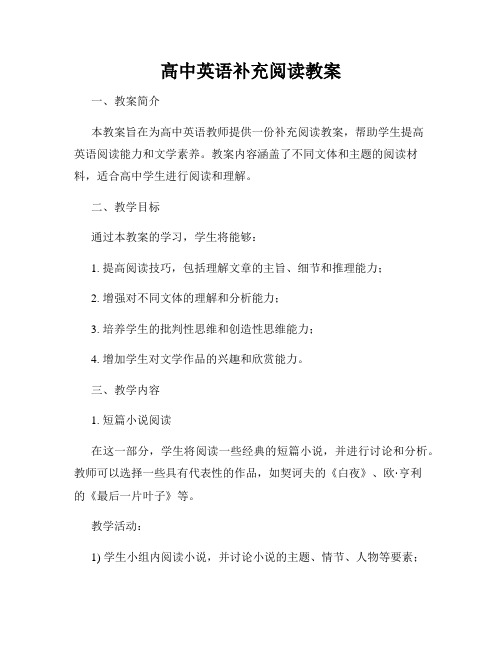
高中英语补充阅读教案一、教案简介本教案旨在为高中英语教师提供一份补充阅读教案,帮助学生提高英语阅读能力和文学素养。
教案内容涵盖了不同文体和主题的阅读材料,适合高中学生进行阅读和理解。
二、教学目标通过本教案的学习,学生将能够:1. 提高阅读技巧,包括理解文章的主旨、细节和推理能力;2. 增强对不同文体的理解和分析能力;3. 培养学生的批判性思维和创造性思维能力;4. 增加学生对文学作品的兴趣和欣赏能力。
三、教学内容1. 短篇小说阅读在这一部分,学生将阅读一些经典的短篇小说,并进行讨论和分析。
教师可以选择一些具有代表性的作品,如契诃夫的《白夜》、欧·亨利的《最后一片叶子》等。
教学活动:1) 学生小组内阅读小说,并讨论小说的主题、情节、人物等要素;2) 学生进行个人或小组演绎,以提高对故事的理解和表达能力;3) 教师引导学生分析文本的语言特点和故事结构。
2. 新闻报道阅读这部分通过阅读新闻报道,使学生了解并关注最新的社会热点和国际动态。
教师可以选择一些有趣且具有教育意义的新闻报道,如科技新闻、社会问题、环保等。
教学活动:1) 请学生在阅读前猜测新闻的主题和内容;2) 学生进行速读,了解大意,并回答相关问题;3) 学生与同伴讨论新闻报道的价值和影响。
3. 文化遗产介绍这部分通过介绍或阅读关于世界各地的文化遗产的文章,增强学生对不同文化的理解和欣赏。
教师可以选择一些世界著名的文化遗产,如埃及金字塔、中国长城等。
教学活动:1) 教师进行文化背景的介绍,并展示相关图片或视频;2) 学生进行阅读,并回答问题,例如这个文化遗产的历史、建筑风格、文化意义等;3) 学生分组进行展示,分享对文化遗产的理解和想法。
1. 创设情境为了激发学生的学习兴趣和积极性,教师可以创设相关的情境,如模拟新闻发布会、组织文学讨论会等,让学生在轻松的氛围中进行学习和交流。
2. 合作学习学生在小组内进行讨论和合作,可以提高学生的语言表达能力和批判性思维能力。
高中英语阅读专项导引教案

高中英语阅读专项导引教案
1. 教学目标
- 增强学生的英语词汇量和语法知识。
- 提升学生的快速阅读与精读技巧。
- 培养学生的批判性思维和分析能力。
- 引导学生学会总结和归纳文章主旨。
2. 教学内容
- 精选适合高中生阅读水平的英文文章,涵盖不同体裁和主题。
- 设计针对性的阅读问题,考察细节理解、推理判断及词义猜测等技能。
- 提供词汇和短语学习,帮助学生扩充语言资源。
3. 教学方法
- 采用任务驱动式教学法,通过具体任务激发学生学习兴趣。
- 实施分层教学,根据学生实际水平提供个性化指导。
- 结合多媒体工具,如视频、音频材料,增加课堂互动性。
4. 教学过程
- 导入:通过提问或讨论引出话题,激发学生兴趣。
- 新课呈现:教师引导学生阅读新材料,共同探讨文章结构和内容。
- 练习:学生独立或小组合作完成练习题,教师巡回指导。
- 总结:回顾本节课学到的知识点,强化记忆。
- 作业布置:根据课堂表现,分配适量的阅读和习题作业。
5. 评价方式
- 进行定期的阅读测试,检验学生的理解和分析能力。
- 通过课堂表现和作业完成情况,评估学生的学习进度。
- 鼓励学生自我评价,反思学习方法和效果。
6. 教学反思
- 教师需不断更新教学材料,确保内容的时效性和相关性。
- 关注学生的个体差异,调整教学策略以满足不同需求。
- 定期收集学生反馈,优化教学方法和过程。
7. 结语。
高中英语阅读课教案
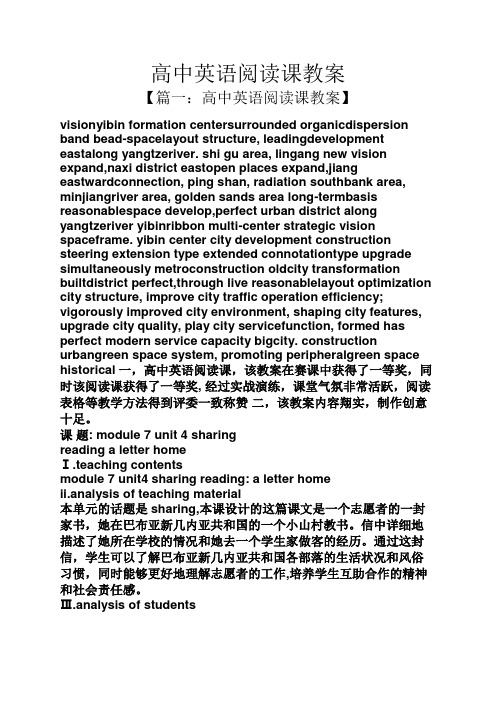
高中英语阅读课教案【篇一:高中英语阅读课教案】visionyibin formation centersurrounded organicdispersion band bead-spacelayout structure, leadingdevelopment eastalong yangtzeriver. shi gu area, lingang new vision expand,naxi district eastopen places expand,jiang eastwardconnection, ping shan, radiation southbank area, minjiangriver area, golden sands area long-termbasis reasonablespace develop,perfect urban district along yangtzeriver yibinribbon multi-center strategic vision spaceframe. yibin center city development construction steering extension type extended connotationtype upgrade simultaneously metroconstruction oldcity transformation builtdistrict perfect,through live reasonablelayout optimization city structure, improve city traffic operation efficiency; vigorously improved city environment, shaping city features, upgrade city quality, play city servicefunction, formed has perfect modern service capacity bigcity. construction urbangreen space system, promoting peripheralgreen space historical一,高中英语阅读课,该教案在赛课中获得了一等奖,同时该阅读课获得了一等奖, 经过实战演练,课堂气氛非常活跃,阅读表格等教学方法得到评委一致称赞二,该教案内容翔实,制作创意十足。
高中英语阅读新概念教案
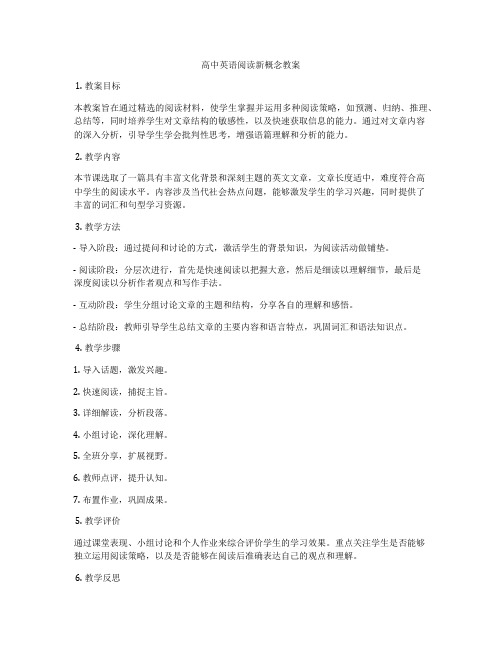
高中英语阅读新概念教案1. 教案目标本教案旨在通过精选的阅读材料,使学生掌握并运用多种阅读策略,如预测、归纳、推理、总结等,同时培养学生对文章结构的敏感性,以及快速获取信息的能力。
通过对文章内容的深入分析,引导学生学会批判性思考,增强语篇理解和分析的能力。
2. 教学内容本节课选取了一篇具有丰富文化背景和深刻主题的英文文章,文章长度适中,难度符合高中学生的阅读水平。
内容涉及当代社会热点问题,能够激发学生的学习兴趣,同时提供了丰富的词汇和句型学习资源。
3. 教学方法- 导入阶段:通过提问和讨论的方式,激活学生的背景知识,为阅读活动做铺垫。
- 阅读阶段:分层次进行,首先是快速阅读以把握大意,然后是细读以理解细节,最后是深度阅读以分析作者观点和写作手法。
- 互动阶段:学生分组讨论文章的主题和结构,分享各自的理解和感悟。
- 总结阶段:教师引导学生总结文章的主要内容和语言特点,巩固词汇和语法知识点。
4. 教学步骤1. 导入话题,激发兴趣。
2. 快速阅读,捕捉主旨。
3. 详细解读,分析段落。
4. 小组讨论,深化理解。
5. 全班分享,扩展视野。
6. 教师点评,提升认知。
7. 布置作业,巩固成果。
5. 教学评价通过课堂表现、小组讨论和个人作业来综合评价学生的学习效果。
重点关注学生是否能够独立运用阅读策略,以及是否能够在阅读后准确表达自己的观点和理解。
6. 教学反思课后,教师需根据学生的反馈和学习成果,对教案进行调整和优化。
这包括调整阅读材料的难度,改进教学方法,或是增加更多互动性和参与性的活动。
高中英语阅读课教学案例
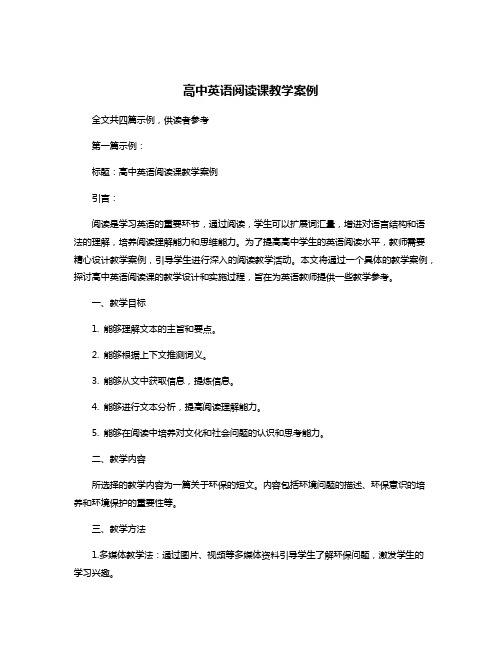
高中英语阅读课教学案例全文共四篇示例,供读者参考第一篇示例:标题:高中英语阅读课教学案例引言:阅读是学习英语的重要环节,通过阅读,学生可以扩展词汇量,增进对语言结构和语法的理解,培养阅读理解能力和思维能力。
为了提高高中学生的英语阅读水平,教师需要精心设计教学案例,引导学生进行深入的阅读教学活动。
本文将通过一个具体的教学案例,探讨高中英语阅读课的教学设计和实施过程,旨在为英语教师提供一些教学参考。
一、教学目标1. 能够理解文本的主旨和要点。
2. 能够根据上下文推测词义。
3. 能够从文中获取信息,提炼信息。
4. 能够进行文本分析,提高阅读理解能力。
5. 能够在阅读中培养对文化和社会问题的认识和思考能力。
二、教学内容所选择的教学内容为一篇关于环保的短文。
内容包括环境问题的描述、环保意识的培养和环境保护的重要性等。
三、教学方法1.多媒体教学法:通过图片、视频等多媒体资料引导学生了解环保问题,激发学生的学习兴趣。
2.启发式教学法:通过提出问题、展示情景等方式引导学生主动思考、发现问题、寻找解决问题的方法。
3.合作学习法:设计小组讨论、合作阅读等活动,让学生在合作中相互学习、思考,激发学生的学习热情。
四、教学过程1.课前导入2.课堂授课以小组活动的形式展示短文内容,让学生对环保问题有一个整体的认识。
然后,教师可以选择一些重点段落进行讲解,重点讲解一些语言点,并进行相关词汇的讲解和拓展。
3.合作学习通过小组讨论、合作阅读等活动,让学生在合作中相互学习、思考,提高阅读理解能力。
学生可以在小组中相互交流想法,共同解决阅读中遇到的问题,增强对环保问题的理解和认识。
4.课堂总结教师对本节课的内容进行总结,鼓励学生对所学知识进行总结和提炼。
可以通过提问、讨论等方式激发学生对环保问题的思考和探索。
五、教学评价教学过程中,教师可以通过观察学生的表现和小组讨论的情况等来对学生的阅读理解能力和综合能力进行评价。
可以设计一些阅读理解题目、课堂问题等进行及时的检测。
高中英语阅读课优秀教案
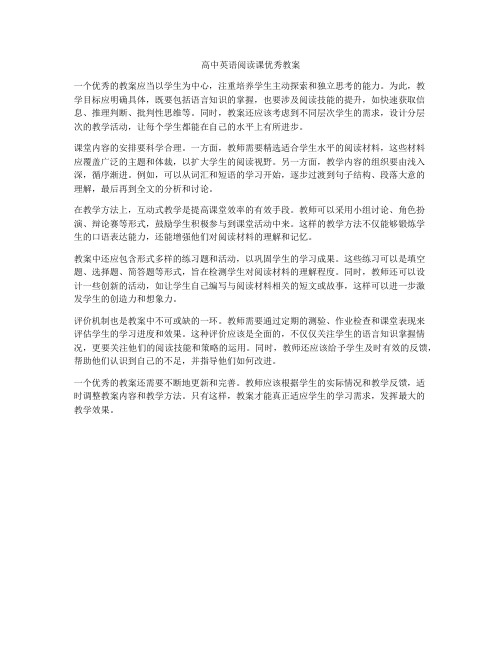
高中英语阅读课优秀教案一个优秀的教案应当以学生为中心,注重培养学生主动探索和独立思考的能力。
为此,教学目标应明确具体,既要包括语言知识的掌握,也要涉及阅读技能的提升,如快速获取信息、推理判断、批判性思维等。
同时,教案还应该考虑到不同层次学生的需求,设计分层次的教学活动,让每个学生都能在自己的水平上有所进步。
课堂内容的安排要科学合理。
一方面,教师需要精选适合学生水平的阅读材料,这些材料应覆盖广泛的主题和体裁,以扩大学生的阅读视野。
另一方面,教学内容的组织要由浅入深,循序渐进。
例如,可以从词汇和短语的学习开始,逐步过渡到句子结构、段落大意的理解,最后再到全文的分析和讨论。
在教学方法上,互动式教学是提高课堂效率的有效手段。
教师可以采用小组讨论、角色扮演、辩论赛等形式,鼓励学生积极参与到课堂活动中来。
这样的教学方法不仅能够锻炼学生的口语表达能力,还能增强他们对阅读材料的理解和记忆。
教案中还应包含形式多样的练习题和活动,以巩固学生的学习成果。
这些练习可以是填空题、选择题、简答题等形式,旨在检测学生对阅读材料的理解程度。
同时,教师还可以设计一些创新的活动,如让学生自己编写与阅读材料相关的短文或故事,这样可以进一步激发学生的创造力和想象力。
评价机制也是教案中不可或缺的一环。
教师需要通过定期的测验、作业检查和课堂表现来评估学生的学习进度和效果。
这种评价应该是全面的,不仅仅关注学生的语言知识掌握情况,更要关注他们的阅读技能和策略的运用。
同时,教师还应该给予学生及时有效的反馈,帮助他们认识到自己的不足,并指导他们如何改进。
一个优秀的教案还需要不断地更新和完善。
教师应该根据学生的实际情况和教学反馈,适时调整教案内容和教学方法。
只有这样,教案才能真正适应学生的学习需求,发挥最大的教学效果。
高中英语简本小说阅读教案

高中英语简本小说阅读教案教学目标:1. 学生能够理解并掌握小说中的关键词汇和短语。
2. 学生能够分析小说的主要情节,并识别作者的写作技巧。
3. 学生能够讨论小说中的主题和角色,表达自己的观点。
4. 学生能够将小说中的情节与现实生活联系起来,进行深入思考。
教学内容:- 选择一部适合高中生阅读的英语简本小说,如《老人与海》或《动物农场》。
- 确定教学的关键词汇和短语。
- 分析小说的结构,包括开头、发展、高潮和结局。
- 探讨小说的主题和角色发展。
教学步骤:第一环节:导入新课(5分钟)- 通过提问或播放与小说相关的短片,激发学生的兴趣。
- 简要介绍小说的背景信息和作者。
第二环节:词汇学习(10分钟)- 列出本章节的关键词汇和短语。
- 通过图片、例句或情境对话帮助学生理解和记忆这些词汇。
第三环节:阅读理解(15分钟)- 让学生默读指定章节,然后回答几个关于情节的问题。
- 分组讨论这些问题的答案,鼓励学生分享不同的理解。
第四环节:文本分析(15分钟)- 引导学生分析小说的结构和作者的写作技巧。
- 讨论小说中的角色如何随着情节的发展而变化。
第五环节:主题讨论(15分钟)- 提出几个与小说主题相关的问题,让学生自由发言。
- 鼓励学生联系自己的生活经验,谈谈对主题的个人看法。
第六环节:语言输出(10分钟)- 要求学生以小组形式创作一个短剧,基于小说的情节或主题。
- 每个小组表演他们的短剧,其他学生提供反馈。
第七环节:总结与作业(5分钟)- 总结今天的教学内容和学生的学习成果。
- 布置作业,如写一篇关于小说主题的短文或绘制一张情节图。
高中英语阅读课优秀市公开课获奖教案省名师优质课赛课一等奖教案

高中英语阅读课优秀教案一、教学目标:1. 提高学生的阅读能力和理解能力,培养学生的阅读习惯和兴趣;2. 培养学生综合运用语言知识进行分析和推理的能力;3. 培养学生的自主学习能力和团队合作意识。
二、教学内容:1. 文体类型:新闻报道类、科普类、散文类等;2. 阅读技巧:主旨大意理解、词汇理解、推理判断等;3. 语言要点:语法、词汇、语篇等。
三、教学过程:1. 导入(5分钟):利用一幅相关图片和引人入胜的开场语导入课堂,引发学生对阅读话题的兴趣。
2. 预读(10分钟):教师给学生分发阅读材料之前,先通过提问的形式激发学生对阅读材料主题的猜测,同时引导学生预测文章的内容。
3. 阅读(30分钟):学生分组进行阅读,每组分配一篇文章,要求学生在规定时间内通读文章,根据文章内容填写相关问题的答案。
4. 理解(15分钟):教师组织学生进行小组讨论,帮助学生理解文章的主旨大意、词汇和主要观点,并解答学生提出的问题。
5. 分析(10分钟):教师引导学生分析文章的结构、语法和词汇运用,帮助学生掌握阅读技巧和语言要点。
6. 合作(10分钟):教师组织学生进行小组合作,让学生在小组内分享自己的阅读心得和问题,并鼓励他们相互帮助,共同提高阅读水平。
7. 拓展(10分钟):教师根据学生的阅读状况,适时给予额外的阅读材料,以拓宽学生的阅读能力和知识储备。
8. 总结(5分钟):教师对整个阅读课进行总结,鼓励学生继续努力阅读,并提出具体的学习建议。
四、教学评价:1. 学生在阅读过程中的参与度和表现;2. 学生对文章内容的理解程度;3. 学生对阅读技巧和语言要点的掌握情况;4. 学生小组合作和分享的积极性和效果。
五、教学反思:通过本节阅读课的教学实践,我发现学生对阅读材料的主题和内容感兴趣,并能较好地运用所学的语言知识进行理解和分析。
但仍有部分学生在阅读过程中遇到一些困难,需要加强引导和指导。
下一步,我将更加关注学生的个性化需求,提供更多优质的阅读资源,以促进学生阅读能力的全面提升。
高中英语阅读课教学案例
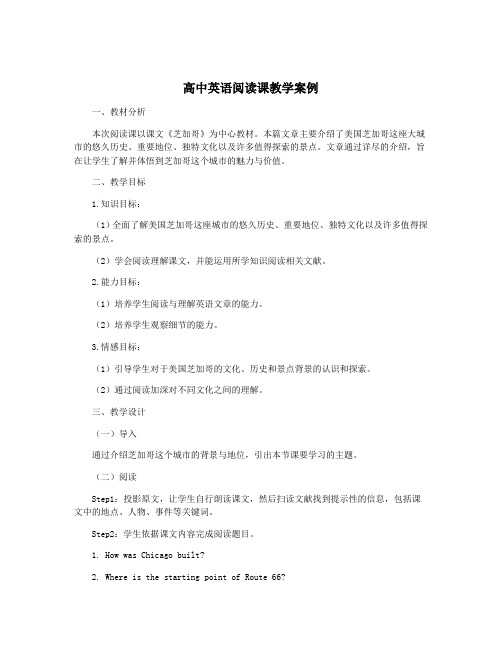
高中英语阅读课教学案例一、教材分析本次阅读课以课文《芝加哥》为中心教材。
本篇文章主要介绍了美国芝加哥这座大城市的悠久历史、重要地位、独特文化以及许多值得探索的景点。
文章通过详尽的介绍,旨在让学生了解并体悟到芝加哥这个城市的魅力与价值。
二、教学目标1.知识目标:(1)全面了解美国芝加哥这座城市的悠久历史、重要地位、独特文化以及许多值得探索的景点。
(2)学会阅读理解课文,并能运用所学知识阅读相关文献。
2.能力目标:(1)培养学生阅读与理解英语文章的能力。
(2)培养学生观察细节的能力。
3.情感目标:(1)引导学生对于美国芝加哥的文化、历史和景点背景的认识和探索。
(2)通过阅读加深对不同文化之间的理解。
三、教学设计(一)导入通过介绍芝加哥这个城市的背景与地位,引出本节课要学习的主题。
(二)阅读Step1:投影原文,让学生自行朗读课文,然后扫读文献找到提示性的信息,包括课文中的地点、人物、事件等关键词。
Step2:学生依据课文内容完成阅读题目。
1. How was Chicago built?2. Where is the starting point of Route 66?4. What is the famous square which is also called the most crowded place in the world?5. Who is Oprah Winfrey?Step3:让学生结合自己的阅读理解与文献信息进行创作。
任务:我要去芝加哥旅游根据刚才阅读的内容,你得知了很多芝加哥的文化、历史和景点背景,请你现在给自己定一个计划,告诉自己需要看到哪些景点,对哪些文化领域感兴趣,需要了解什么历史事件,并给自己一个总结。
写一个约100词左右的计划及总结。
(三)练习除了阅读和理解外,对于课文相关的生词、短语和句型也需要进行适当的强化练习。
(四)拓展设想一下你正在芝加哥旅游,有以下不懂得信息,请你与同桌探讨如何解决问题,并且进行口语表达。
高中英语教案(优秀8篇)

高中英语教案(优秀8篇)高中英语教学设计篇一单元整体设计思路第一课时:阅读课Warming up; Pre-reading; Reading; Comprehending (pp. 1-2)第二课时:语法课Discovering useful structures (p. 4); Using structures (p. 43)第三课时:阅读与听说课Reading and listening; Speaking (pp. 5-6)第四课时:词汇课Discovering useful words and expressions (p. 3); Using words and expressions (p. 42)第五课时:听说课Listening; Talking (p. 41)第六课时:读写课Reading and writing (p. 7)第七课时:单元评价课Self-test and self-evaluation; Summary第一课时阅读课一、教学内容Warming up; Pre-reading; Reading; Comprehending (pp. 1-2)二、教学目标在本节课结束时,学生能够了解文化遗产的基本概念、本质特点以及基本类型。
通过找读(scanning)关键词、略读(skimming) 和精读(careful reading),了解有关琥珀屋的故事。
用归类法学习词汇。
用自己的话复述琥珀屋的故事。
运用本课时学习的内容和自己已有的知识讨论相关话题。
三、教学步骤步骤一热身1.请学生看学生用书p. 1或者PPT中的图片,两人一组讨论三个问题。
教师请几组学生回答问题,然后综合大家的看法总结出文化遗产的定义。
2. 请学生说出一些中外文化遗产的名称,教师写在黑板上。
可以采取小组竞赛的形式,比一比看哪组说得多、说得正确。
注:问题中出现了五个生词。
rare, valuable和survive很难根据上下文猜出词义,教师可以布置学生课前查字典自学其词义,用法可以留到词汇课处理。
高中英语阅读课教案
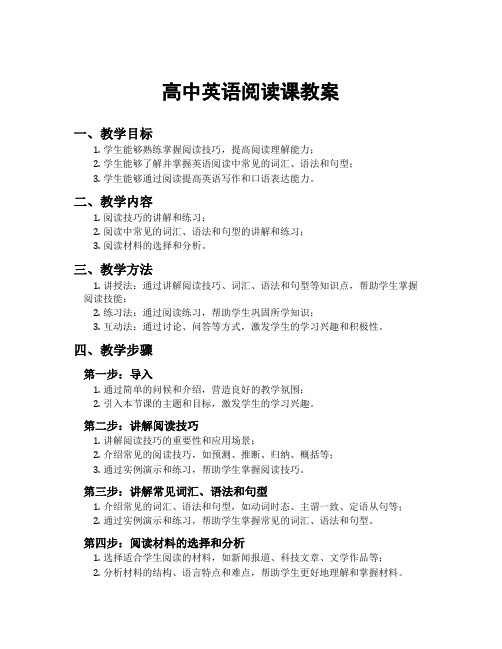
高中英语阅读课教案一、教学目标1.学生能够熟练掌握阅读技巧,提高阅读理解能力;2.学生能够了解并掌握英语阅读中常见的词汇、语法和句型;3.学生能够通过阅读提高英语写作和口语表达能力。
二、教学内容1.阅读技巧的讲解和练习;2.阅读中常见的词汇、语法和句型的讲解和练习;3.阅读材料的选择和分析。
三、教学方法1.讲授法:通过讲解阅读技巧、词汇、语法和句型等知识点,帮助学生掌握阅读技能;2.练习法:通过阅读练习,帮助学生巩固所学知识;3.互动法:通过讨论、问答等方式,激发学生的学习兴趣和积极性。
四、教学步骤第一步:导入1.通过简单的问候和介绍,营造良好的教学氛围;2.引入本节课的主题和目标,激发学生的学习兴趣。
第二步:讲解阅读技巧1.讲解阅读技巧的重要性和应用场景;2.介绍常见的阅读技巧,如预测、推断、归纳、概括等;3.通过实例演示和练习,帮助学生掌握阅读技巧。
第三步:讲解常见词汇、语法和句型1.介绍常见的词汇、语法和句型,如动词时态、主谓一致、定语从句等;2.通过实例演示和练习,帮助学生掌握常见的词汇、语法和句型。
第四步:阅读材料的选择和分析1.选择适合学生阅读的材料,如新闻报道、科技文章、文学作品等;2.分析材料的结构、语言特点和难点,帮助学生更好地理解和掌握材料。
第五步:阅读练习1.让学生阅读选定的材料,并根据所学知识点进行理解和分析;2.通过问答、讨论等方式,帮助学生深入理解和掌握材料。
第六步:总结1.总结本节课的主要内容和要点;2.强调学生需要在日常学习中多加练习,提高阅读能力和英语表达能力。
五、教学评估1.通过课堂练习和作业评估学生的阅读理解能力和英语表达能力;2.通过课后反馈和讨论,了解学生对本节课的掌握情况和反馈意见,为下一节课的教学做好准备。
六、教学建议1.教师应该根据学生的实际情况和需求,选择适合的阅读材料和教学方法;2.学生应该积极参与课堂讨论和练习,多加练习,提高阅读能力和英语表达能力。
- 1、下载文档前请自行甄别文档内容的完整性,平台不提供额外的编辑、内容补充、找答案等附加服务。
- 2、"仅部分预览"的文档,不可在线预览部分如存在完整性等问题,可反馈申请退款(可完整预览的文档不适用该条件!)。
- 3、如文档侵犯您的权益,请联系客服反馈,我们会尽快为您处理(人工客服工作时间:9:00-18:30)。
高中英语阅读课教案:LESSON PLANTime of Lesson: 45 minutesStudents: Senior Grade OneTeaching Material: How Did Postage Stamps Come Into UseTeaching Objectives:1. To train Ss\' reading ability(such as guessing the meaning of new words in the context, the speed of reading.)2. To train Ss\' reading comprehension(To get messages from what they read.)Teaching Points:1. Ss get used to three reading skills.2. Ss understand the given passage.Properties:Stamps, letters, postcards, work sheets, OHPTeaching Method:Communicative ApproachLesson Type:ReadingNew Words and A Phrase:postage, put forward, proposal, seal, deliver, system, postalProcedures:Step 1. Warm-up(6\')1. Lead-inShow some stamps, letters and postcards and have free talk to arouse students\' motivation.2. Dealing with some new wordsQ: Do you know the postage of a letter?Explain \"postage\", and write postage on the Bb.postage: payment for the carrying of lettersA: Fifty fen for any place in China except Hong Kong, Taiwan and Macao.Q: What do the postmen do with the letters?A: They take the letters from the postbox and carry them away to the places on the envelopes and deliver them to the addressed people.Explain \"deliver\", and write deliver on the Bb.deliver: take letters or goods to the addressed people.Q: Who put forward the proposal to use stamps? Use OHP to project the question onto the screen.Explain \"put forward\" and \"proposal\", and write them on the Bb.put forward: put an idea before people for thinking overproposal: sth. proposed, plan or idea, suggestionAgain: Who put forward the proposal to use stamps?Step 2. Skimming(4\'30\")1. InstructionsT: Now I give you a passage to read, and for the first time you should only find the answer to the question. You have only two and a half minutes to read. So don\'t read word for word. Read quickly. Just try to find the answer.2. Handing out the reading material and reading3. CheckingQ: Who put forward the proposal to use stamps.A: Rowland Hill, a schoolmaster in England.Step 3. Scanning(6\')1. InstructionsT: This time I give you three minutes to read the passage. When you are reading, find the answers to the two questions. Use OHP to project the questions:1. Why was the postage high in the early nineteenth century when people did not use stamps?2. When was postage stamps first put to use?2. Reading3. Checking1) Pair work2) Class checkingAns. to Que.1. Because the post offices had to send many people to collect the postage.Ans. to Que.2. On May 6, 1840.Step 4. Full reading(21\')1. InstructionsT: Now I give you ten minutes to read the passage for the third time and you should read it carefully. Before reading, let\'s go over the questions on the work sheet.Give Work Sheet 1 to the Ss. Explain the new words in Que. 4.prevent: stop, not let sb. do sth.reuse: use againT: Try to find the answers to the questions. But don\'t write the answers down, you can put a sign or underline the sentences concerning the questions.2. Reading3. Checking1) Group work: Checking the answers in a group of four Ss.2) Class work: Checking the answers in class.Possible Answers:1. Why were people unhappy to pay postage for letters in the early nineteenth century?Because they had to pay postage when they received letters, especially when they paid for a letter which they did not wish to receive at all. The postage was high.2. Why was it much easier for people to use stamps for postage?Because people could go to the nearby post office to buy stamps and put them on envelopes before they sent the letters.3. Why was the postage much lower using stamps?Because in this way, the post office did not need to send postmen to collect postage. It only needed to send fewer postmen to deliver letters.4. How could the post office prevent people from reusing the stamps?The post office could simply put seals on the stamps so that people could not use the stamps again.Check the understanding of the word \"seal\", and write it on the Bb.seal: ÓÊ´Á 5. Did other countries take up the new postal system?Yes.Check the understanding of \"postal\" and \"system\", and write them on the Bb.postal: of the postsystem: a set of working ways6. Does every country in the world has its own stamps?Yes.Step 5: Rounding-off(7\')1. Answering Ss\' questions on the passage if any.2. Making a guided-dialogue with the information given from the passage.Hand out Work Sheet 2. Do it in pairs.3. Asking two or three pairs to read their dailogues.A possible completed dialogue:A: Oh, What a beautiful stamp!B: Yes, it\'s from the U.S.A..A: Do you know in the early nineteenth century people did not use stamps?B: Then how did they pay the postage?A: They had to pay the postage when they received letters.B: Was the postage very high then?A: Yes. Because the post offices had to send many people to collect the postage.B: Who put forward the proposal to use stamps?A: Rowland Hill, a schoolmaster in England.B: Why do post offices put seals on the stamps?A: They can prevent people from using the stamps again.B: When did post offices begin to sell stamps?A: On May 6, 1840.B: Thank you for telling me so many things about stamps.Step 6. Assignment(30\")Ask the Ss to shorten the passage within four or five sentences after class, and to write it in their exercise books.*************************************************************Reading Material:How Did Postage Stamps Come Into UseWhen you send a letter or a postcard, you have to put stamps on the envelope or on the card. When did people first begin to use stamps? Who was the first to think of this idea?In the early nineteenth century, people did not use stamps. They had to pay postage when they received letters. They were unhappy about this, especially when they paid for a letter which they did not wish to receive at all. The postage was high at that time, because the post offices had to send many people to collect the postage.Rowland Hill, a schoolmaster in England, was the first to put forward a proposal to use stamps. He thought it would be much easier for people to use stamps to cover postage. They could go to the nearby post office to buy stamps and put them on envelopes before they sent the letters. The post office could simply put seals on the stamps so that people could not use the stamps again. In this way, the post office did not need to send postmen to collect postage. It only needed to send fewer postmen to deliver letters. That was a good idea and the government finally accepted it.On May 6, 1840, post offices throughout England began to sell stamps. Soon this new postal system was taken up by other countries. Now each country has its own stamps. And there are many people who collect stamps all over the world. Work Sheet 1:Find the answers to the following questions from the passage:1. Why were people unhappy to pay postage for letters in the early nineteenth century?2. Why was it much easier for people to use stamps for postage?3. Why was the postage much lower using stamps?4. How could the post office prevent people from reusing the stamps?5. Did other countries take up the new postal system?6. Does every country in the world has its own stamps now?Work Sheet 2:Complete the dialogue with the information you have got:A: Oh, What a beautiful stamp!B: Yes, it\'s from the U.S.A..A: Do you know ____________________ people did not use stamps?B: Then how did they pay the postage?A: ___________________________________________________________.B: Was the postage very high then?A: ___________________________________________________________.B: Who put forward the proposal to use stamps?A: ___________________________________________________________.B: Why do post offices put seals on the stamps?A: ___________________________________________________________.B: When did post offices begin to sell stamps?A: ___________________________________________________________. B: Thank you for telling me so many things about stamps.。
